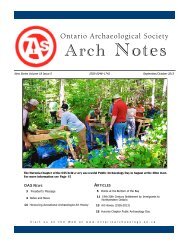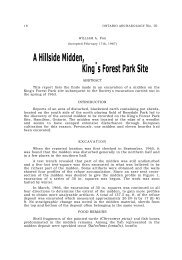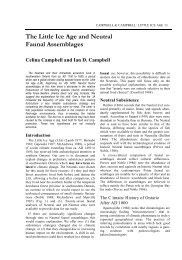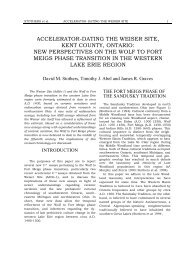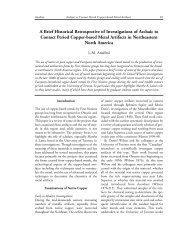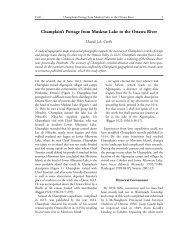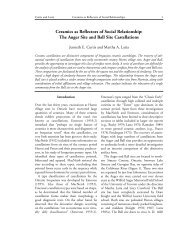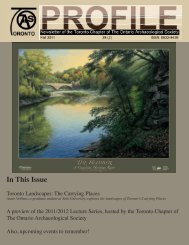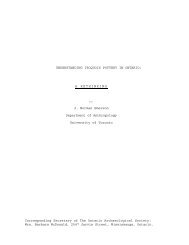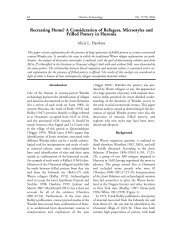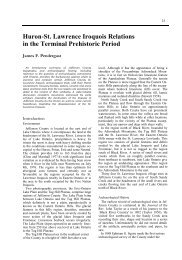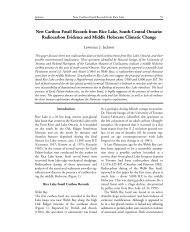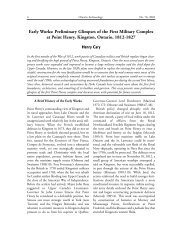ST LAWRENCE IROQUOIAN BURIAL PRACTICES James F ...
ST LAWRENCE IROQUOIAN BURIAL PRACTICES James F ...
ST LAWRENCE IROQUOIAN BURIAL PRACTICES James F ...
Create successful ePaper yourself
Turn your PDF publications into a flip-book with our unique Google optimized e-Paper software.
PENDERGA<strong>ST</strong>: <strong>ST</strong> <strong>LAWRENCE</strong> IROQUOIS <strong>BURIAL</strong> 49<br />
<strong>ST</strong> <strong>LAWRENCE</strong> <strong>IROQUOIAN</strong> <strong>BURIAL</strong> <strong>PRACTICES</strong><br />
<strong>James</strong> F. Pendergast<br />
AB<strong>ST</strong>RACT<br />
The paucity of graves on the Roebuck prehistoric St Lawrence Iroquoian village, relative<br />
to the estimated peak population of approximately 2,000 over a 12 to 20 year life span, is<br />
noted. The preponderance of females in the adult grave population is examined and<br />
explanations are suggested to account for the very few adult male graves present.<br />
INTRODUCTION<br />
The 85 graves excavated at the Roebuck village site which are described by Wintemberg<br />
(1936:114) and Knowles (1937) constitute the largest body of data available on St Lawrence<br />
Iroquoian burials. Certain implications arising from these data invite a discussion of St<br />
Lawrence Iroquoian burial practices.<br />
THE VILLAGE<br />
The Roebuck village site occupies approximately 3 hectares or 8 acres (Wintemberg<br />
1936:2). Premised on two families sharing a hearth Wright (1979:68-69) has estimated that<br />
some 30 longhouses accommodated a peak population of approximately 2,000 people. This<br />
estimate compares well with Tooker's (1964:40) interpretation of the Jesuit Relations<br />
regarding Huron villages. By linear extrapolation it also compares well with the 1,200<br />
population for 6 acres suggested by Heidenreich (1971:133) for Huron villages and the 1,500<br />
to 2,000 range proposed by Trigger (1976:32) for large Huron villages. Noble has indicated<br />
to Heidenreich that Neutral villages were roughly the same size as the Huron (Heidenreich<br />
1971:126). Heidenreich has also compared Huron villages with Mohawk, Oneida and<br />
Seneca villages for which ethnohistoric data are available and in part concludes that "New<br />
York Iroquois villages lie within the size range of Huron villages" (1971:126-127). Because<br />
Roebuck remains the only St Lawrence Iroquoian village excavated extensively data are<br />
not available on which to premise St Lawrence village area/population ranges for<br />
comparison. Although a significant portion of the Roebuck site within the earthworks<br />
recorded by Guest (1856) during his visit in 1854 remains unexcavated, Wright's estimate<br />
of the Roebuck population remains realistic. It is noteworthy that the earthworks recorded<br />
by Guest have not yet been revealed by excavation.<br />
THE HUMAN REMAINS EXCAVATED<br />
Wintemberg (1936:118-119) excavated 85 skeletons at Roebuck. Knowles (1937:1)<br />
describes 84. Most of these are from individual interments although a few are multiple<br />
( Wintemberg 1936:114; Knowles 1937:8). Knowles (1937:2) states: "The skeletal remains<br />
from the graves are undoubtedly remains of the people who inhabited the site." These<br />
graves do not pertain to the cannibalized, disarticulated and fragmentary human bone<br />
Pendergast, <strong>James</strong> F.<br />
1983 St Lawrence Iroquoian Burial Practices. Ontario Archaeology 40:49-56.
50 ONTARIO ARCHAEOLOGY NO. 40<br />
excavated in the refuse which Knowles (1937:4) estimates to represent as many as 35<br />
additional individuals. Wintemberg (1936:120) believes these cannibalized bones "may<br />
have been people of the site but it is more likely that most of them are the bones of enemies<br />
who had been roasted and eaten." Knowles (1937:5) indicates 31 of these 35 individuals were<br />
young men and he too believes they are the bones of captives (1937:2).<br />
Knowles (1937:8) states that 43 of the 84 villagers buried in graves are adult and 41 are nonadults<br />
"comprising children and those individuals who has not attained their full growth."<br />
Thirty-nine of the adults are women of which "7 were young, eight under middle-age, 11<br />
were middle age or over and thirteen elderly and aged" Knowles (1937:10). Only 4 are adult<br />
males. Two of these were over middle age and 2 were "probably of young middle age"<br />
( Knowles 1937:10). Knowles's detailed descriptions of these male skeletons indicate that 2<br />
present pathological conditions. The face of one of the over middle age individuals (Cat. no.<br />
XIII. F. 17) "is of somewhat unusual type: the malar bones are small for an Indian and do<br />
not project to the same extent as is usual." He notes that he "has noticed the not unusual<br />
occurrence among Iroquoian crania of this comparatively slight-faced type." One young<br />
middle age individual (Cat. no. XIII. F. 251) has "a large, rough, bony growth on the<br />
interior of the occipital bone. The outer surface at this point the bone is porous and there<br />
is present a small inflammatory patch." Aside from these there are no anomalies in the 4 male<br />
skeletons. The 41 non-adult burials include 7 infants, 6 older individuals to age two years,<br />
7 older individuals to age five years, 12 older individuals to age ten years and 5 older<br />
individuals to age fifteen years (Knowles 1937:8). The sex of these individuals is doubtful. Of<br />
the 4 remaining non-adults Knowles describes between ages fifteen and nineteen years, 3<br />
are females and 1 is a male. Hereafter in this paper this nineteen-year-old male `non-adult'<br />
will be considered a young warrior.<br />
THE VILLAGE LIFE-SPAN<br />
It would be difficult to attribute with certainty a specific number of years to the life-span<br />
of the Roebuck village site. However the extent and depth of the refuse, the number and<br />
distribution of the longhouses and the extent of the palisades makes it reasonable to<br />
postulate a mid-term or late position in the 12 to 20 years usually attributed to an Iroquoian<br />
village (Tooker 1964:42). While he does not suggest a specific life-span for the Roebuck<br />
settlement, Wintemberg's remarks (1936:124) generally support this estimate.<br />
THE PROBLEM<br />
These data raise the question: Can the 85 (84) individuals excavated at Roebuck represent<br />
the majority, let alone all, of the dead of a population which at one time during a 12 to 20 year<br />
period peaked at 2,000?<br />
A RECON<strong>ST</strong>RUCTED VILLAGE POPULATION<br />
Before attempting to reply to this question it would be appropriate to examine the<br />
circumstances which attended the collection of the human remains at Roebuck<br />
(Wintemberg 1936:114-120; Knowles 1937). By scaling from Wintemberg's excavation map<br />
it has been calculated that 0.77 hectares (1.89 acres) were excavated in 1912 and 1915. In 1970<br />
Wright (personal communication 1983) excavated 0.04 hectares (0.1 acres). In all 1.99 acres<br />
or approximately one-quarter of the 8 acre site have been excavated. It can be claimed with<br />
some validity that an assessment of total village mortality requires that there be data
PENDERGA<strong>ST</strong>: <strong>ST</strong> <strong>LAWRENCE</strong> IROQUOIS <strong>BURIAL</strong> 51<br />
available on the total village grave population. It is proposed to examine this thesis using an<br />
arithmetical extrapolation of the available data on the premise that the incidence and<br />
nature of the burials in the unexcavated portion of the site are the same as that revealed in<br />
the excavated portion.<br />
On this basis, using Knowles's data (84 graves, 83 plus one nineteen-year-old `non-adult'<br />
male here judged to be a young warrior) the village total of adult graves would be 336. Fiftytwo<br />
percent of Knowles's graves were adults; hence of the 336 total 176 would be adults.<br />
Eleven percent of Knowles's adults were males; hence 37 of the 336 calculated total might<br />
be expected to be male adults. Using Wintemberg's data (85 graves, 35 of which were adults)<br />
the total village adult grave population would be 340 and the total number of adult graves,<br />
41%, would be 139. Twenty-six percent of Wintemberg's adults were male; hence 88 of the<br />
340 graves would be male adults.<br />
These data, although somewhat artificial and subjective, permit the question to be<br />
rephrased: Can 340 (336) individuals represent the majority of the dead of a population<br />
which, over a 20 year period, peaked at 2,000?<br />
VILLAGE MORTALITY<br />
Dr. Jerome S. Cybulski, Physical Anthropologist, Archaeological Survey of Canada,<br />
National Museum of Man, when discussing the Wintemberg/Knowles data noted that<br />
demographic calculations premised on a population of 2,000 with an average prehistoric<br />
mortality rate of 4% per annum would yield nearly 1,600 dead over a period of 20-years;<br />
assuming a stable population annually over that period and a comparable fertility rate.<br />
Churcher and Kenyon (1960) in their paper on the Tabor Hill Ossuaries have suggested a<br />
2.4 to 3% mortality rate. Using the mid-point 2.7 percent mortality rate to avoid inflating<br />
the grave population which would create a greater disparity than has been noted, the<br />
Roebuck dead over a 20 year period would be 1,080. The figures derived from these estimates<br />
are significantly higher than the 340/336 calculated total village grave population and the<br />
85/84 population excavated by Wintemberg.<br />
While it is possible that village movement could have resulted in there being a sizeable<br />
population on the Roebuck site from the outset, it is inappropriate to assume that the<br />
peak population of 2,000 prevailed over the whole of the village life-span. As a basis for<br />
further comparison it will be assumed that the average annual population over a 20-year<br />
village life-span was 1,000. In this case, using the lower 2.7 percent mortality rate, 540 dead<br />
might be expected. This too is significantly higher than the Wintemberg archaeological<br />
sample (85/84) and the calculated total village grave population (340/336).<br />
THE PAUCITY OF MALE GRAVES<br />
Even without involving technical demographic data, the relative incidence of males and<br />
females at Roebuck is anomalous and the distribution of adult males by age groups is<br />
abnormal. Knowles (1937:9) states that only 4 of the 43 adult skeletons are males. By<br />
accepting the likelihood that the one male in Knowles's `non-adult' category between ages<br />
fifteen and nineteen years was a young male warrior, Knowles's adult male total rises to<br />
5 or 11%. Wintemberg (1936:118-119) indicates that 9 of the 35 adult burials are males. This<br />
prompts a second question: Where are the graves of the adult male villagers? Corollary<br />
questions concerning the reasons for the separation of the male graves and the nature of<br />
the social customs on which the separation of the males might be premised hurry to mind.
52 ONTARIO ARCHAEOLOGY NO. 40<br />
DISCUSSION<br />
Knowles (1937:10) recognizing this incongruity speculated: "Possibly in the unsettled<br />
state of existence at that time, as is evidenced by the skeletal remains in the refuse deposits,<br />
the men of the tribe during the occupancy of this site may have usually met their end when<br />
engaged in forays, for as we have already seen from the survey of the scattered bones among<br />
the ashes, the majority of the individuals represented by these remains were young men in<br />
the prime of life." However it was the Huron practice to return the bones of those who died<br />
outside Huronia to their village for burial (Tooker 1964:132). Knowles goes on: "If this<br />
theory is untenable, it must be concluded that there was some other method of burial in use,<br />
one applicable only to the men, although the presence of a few male skeletons among the<br />
burials and the fact that they include men of various ages, seems to render this unlikely."<br />
It is interesting if not wholly germane to note that a paucity of adult male burials has been<br />
noted among the Washington-Boro Basin Susquehannock (Heisey and Witmer 1962:104).<br />
There "the ratio of female to male skeletons in the cemetery (Blue Rock) is too high in<br />
relation to the probable ratio in the population. This also seems to be true in other known<br />
Susquehannock cemeteries." It is suggested that there too males who died on hunting or<br />
raiding expeditions were not returned for burial in the village cemetery. This contrasts<br />
sharply with modern Iroquoian burial practices which strongly favour the body being<br />
brought home for burial (Tooker 1964:132).<br />
The Roebuck burials can also be examined in the light of the burial pattern observed at<br />
the Beckstead site on the basis of burial `find places' (Pendergast n.d.a: Table 57). There the<br />
human remains found in the palisade/embankment works were disarticulated and<br />
fragmented. Disarticulated concentrations of human bone were also found in pits and<br />
posthOles in the houses. They are believed to be discarded slain enemy. Intact graves in the<br />
houses, including a mother and child, children and adolescents, and a cluster of adult graves<br />
between the houses and in an open village area are believed to be those of the villagers buried<br />
with care. Generally there was the impression at Beckstead that the villagers were buried in<br />
the houses or in the village in cemetery areas while slain enemy were discarded to be covered<br />
by the accumulation of village debris. Or if they were fragmented, they were `thrown out<br />
in the garbage.'<br />
At Roebuck Wintemberg's excavations were largely in the middens and in the palisade<br />
works which he traced around three sides of the site. On the basis of the generalization which<br />
arose from observations at Beckstead all of the Roebuck human remains, less burials 53-75,<br />
having been found in or under middens or in the palisade works could be attributed to slain<br />
enemy. But the intact flexed burials described by Wintemberg (1936: 114-119) as having been<br />
found in those locations do not reflect the treatment accorded slain enemy. Burials 1-13 in or<br />
under Midden 1 immediately outside the south side palisade are "in a nearly straight row<br />
across the bottom of the hill and at nearly regular intervals." These are the graves of<br />
children, multiple children and mother and child. Their arrangement is reminiscent of<br />
burial in an emotion-charged cemetery. Burials 79-80 in the palisade works are likely<br />
mother and child. Burial 28 in Midden 1 and in close proximity to the palisade is believed to<br />
have been in a grave house. These are but examples of a number of graves in middens or in<br />
the palisade works which are not compatible with the treatment usually accorded a slain<br />
enemy. Graves 23, 29, 63 and 75 are examples of human finds which being disarticulated or<br />
in ash dumps are likely to be slain enemy. Further, if the Beckstead generalities were to be<br />
applied to the Roebuck burials those in the village area are likely to be villagers buried with<br />
care in cemetery areas. But that is not the case at Roebuck. Graves 71-73 which are located in
PENDERGA<strong>ST</strong>: <strong>ST</strong> <strong>LAWRENCE</strong> IROQUOIS <strong>BURIAL</strong> 53<br />
the village area are disarticulated mutilations in keeping with the fate met by an Iroquoian<br />
enemy. In addition Dawson's description of the burials on the Dawson site (Hochelaga?)<br />
( Pendergast and Trigger 1972: 155) indicating that they were "Around the outskirts of the<br />
town, and in some cases within its limits ..." suggests burials occurred significantly beyond<br />
the palisade line.<br />
Questions regarding the paucity of burials on the Roebuck site relative to the estimated,<br />
or the calculated, village population and life-span and the near absence of males evoke a<br />
common response. The graves must be elsewhere. Or the St Lawrence Iroquoians did not<br />
practise burial in the ground to the extent believed heretofore. Certainly the respect shown<br />
friendly dead by the Iroquoians (Tooker 1964: 128-140) would not support a model in which<br />
village dead were discarded to be destroyed by scavengers. Knowles's suggestion<br />
notwithstanding, it seems unlikely that over a span of 12 to 20 years only 5 male warriors<br />
would survive to be buried in the village. And warfare would not explain the absence of<br />
adult male and female burials in the quantities that might be expected to accumulate over<br />
the village life-span from causes other than war. Neither would it explain the absence of an<br />
accumulation of adult female graves that might be expected regardless of why the males died<br />
or where and how they were buried. Possibly the 4 middle-aged males were interred in the<br />
village apart from their peers because they held, or did not hold, a special or particular<br />
social, military, religious or political status. Williamson (1978:19) raises the possibility of<br />
Huron individuals being accorded a special status burial. Apart from special infant burial<br />
practices (Kapches 1976) certain adult Huron were buried apart from their peers and in a<br />
particular manner different from that accorded the remainder of the community. Those<br />
who died a violent death, from cold, in war, or shipwreck were burned, or buried immediately<br />
not to be exhumed later for ceremonial ossuary burial (Tooker 1964:132).<br />
The season of the year seems likely to have dictated the manner and the location used to<br />
dispose of the dead. In winter with the ground frozen solid to a considerable depth for a<br />
prolonged period it would have been difficult, even impossible, to bury the dead. Melbye<br />
(1978:25), has suggested that this may have been a deciding factor as to whether the dead<br />
were cremated or buried in the Archaic period in the Great Lakes region. Pendergast (n.d.a.:<br />
53) has speculated that the inability to bury the dead in winter led the St Lawrence<br />
Iroquoians to inter some children, adolescents and mothers with infants preferentially<br />
inside the longhouse, where the ground was less frozen, to avoid the hazards of a surface<br />
burial. Regrettably insufficient St Lawrence Iroquoian graves have been excavated to test<br />
the incidence of longhouse burials relative to the total village grave population.<br />
In the event the remainder of the dead at Roebuck, particularly males, are buried<br />
elsewhere, are they buried in cemeteries? This was frequently the practice of the Iroquois in<br />
New York State. There cemeteries "seem often to be located quite a distance from the<br />
village ..." (Ritchie 1965:323). On the other hand, Huron cemeteries, which represent their<br />
initial scaffold burial practice, were "nearby" the village (Trigger 1976:51), sufficiently so<br />
as to be threatened should the village catch fire. Or are they in an ossuary apart from the<br />
village as was the Huron practice? Although they have not been excavated during this<br />
century, `bone pits' are reported in Jefferson County, New York State, in close proximity to a<br />
large cluster of St Lawrence Iroquoian sites (Squire 1851; Hough 1854). Beauchamp<br />
(1892:80) notes: "As Cusick (1825:30) states the Iroquois changed burial systems from time<br />
to time ..." then having explained that ossuary burial was not a custom among the eastern<br />
Iroquois (Onondaga, Oneida and Mohawk) he remarks "Except in Jefferson County bone<br />
pits hardly occur as far east as Onondaga." Regrettably details on these `bone pits' are still<br />
lacking. One of these pits is described as ". . . ten to twelve feet square by perhaps four feet
54 ONTARIO ARCHAEOLOGY NO. 40<br />
deep in which are promiscuously heaped together a large number of human skeletons"<br />
(Squire 1851:25). Another was ". . . a pit about six feet square and four feet deep . . . filled<br />
with human bones all well preserved but in fragments. Upwards of forty pairs of patella<br />
were counted . . . all the bones are those of adults . . . no relics of any kind were found with<br />
them ..." (Squire 1851:25). A number of large stones were heaped on this pit. Beauchamp<br />
(1886) in a paper read to the Jefferson County Historical Society remarked "One thing of<br />
special interest in Jefferson County is the occurrence of bone pits, which suggest the<br />
ossuaries of Canada (with which he was familiar) but on a smaller scale." There is the<br />
possibility of an ossuary in connection with the late prehistoric St Lawrence Iroquoian<br />
Glenbrook site (Pendergast 1981:29).<br />
It may be that scaffold burial near, but outside the village, was practised by the St<br />
Lawrence Iroquoian either as an interim or a terminal interment. The Huron used scaffold<br />
burial as an interim interment during the years between Feast of the Dead ossuary burials<br />
(Trigger 1976:85). Primary scaffold burial and/or terminal ossuary burial may have been<br />
introduced at the same time, and possibly for the same reasons, that other Huron traits<br />
appear on late prehistoric St Lawrence Iroquoian sites in eastern Ontario and Jefferson<br />
County, New York State. Tooker (1964:131) quotes a number of references to scaffold burial<br />
among the Five Nation Iroquois.<br />
There remains the possibility that the paucity of graves at Roebuck is evidence of there<br />
being a smaller village population than has been estimated. Estimating Iroquoian village<br />
population is a tenuous art. Although it is unlikely that all houses excavated on a site are<br />
contemporaneous, the allocation of houses to specific time periods over the life of the site is<br />
uncertain in all but very special circumstances. In addition there is ample evidence that not<br />
all structures in the village were houses. Sagard (Wrong 1939:115, 149, 152, 161, 178)<br />
mentions some of these. There are also the problems which arise as a result of there being but<br />
one family to a hearth in some houses. This is indicated by there being a bunkline on only<br />
one wall in some St Lawrence Iroquoian longhouses (Wright 1972:83; Barre et Girouard<br />
1978:48; Pendergast n.d.a.).<br />
CONCLUSION<br />
The implications of burial pattern observed at Roebuck are significant. If quantities of<br />
skeletons can not be found in association with the St Lawrence Iroquoian village sites<br />
which are in keeping with current population estimates, (say within 5 to 10% although that<br />
may be too high), or satisfactory reasons be given to explain their absence, then consideration<br />
must be given to accepting a compensatory decrease in current population estimates or<br />
village life-spans — possibly both. In the meantime it would seem prudent to avoid<br />
generalizing that St Lawrence Iroquoian burial practices are limited to an 'in-the-ground/<br />
in-the-village' mode. Their mortuary customs and associated social customs appear to be<br />
more complex than has been appreciated. Clearly there is a need to excavate large areas of<br />
St Lawrence Iroquoian village sites to clarify the problems which arise as a result of the<br />
burial practices observed to date at Roebuck.<br />
ACKNOWLEDGEMENTS<br />
I wish to thank J.S. Cybulski, J.V. Wright and B.G. Trigger for their having read an early<br />
draft of this paper. Their comments helped to expand and refine certain facets, improving it<br />
considerably. Nevertheless, I remain wholly responsible for the views I have set out here.
PENDERGA<strong>ST</strong>: <strong>ST</strong> <strong>LAWRENCE</strong> IROQUOIS <strong>BURIAL</strong> 55<br />
REFERENCES CITED<br />
Barre, Georges et Laurent Girouard<br />
1978 Les Iroquoiens: premiers agriculteurs. In Images de la Prehistoire du<br />
Quebec, Recherches Amerindiennes au Quebec VII (1-2):43-54.<br />
Beauchamp, W.M.<br />
1886 The Aborigines: Traces of a People Long Since Departed. Paper presented<br />
to the Jefferson County (New York) Historical Society, 12 October 1886.<br />
1892 The Iroquois Trail or Foot-Prints of the Six Nations in Customs,<br />
Traditions and History. H.C. Beauchamp, Reorder Office, Fayetteville,<br />
New York.<br />
Churcher, C.S., and W.A. Kenyon<br />
1960 The Tabor Hill Ossuaries: A Study in Iroquois Demography. Human<br />
Biology 23(3):249-273.<br />
Cusick, David<br />
1825 Sketches of Ancient History of the Six Nations. Lockport, New York.<br />
Guest, W.E.<br />
1856 Ancient Indian Remains near Prescott, C.W. Smithsonian Report: 271-276.<br />
Washington, D.C.<br />
Heidenreich, Conrad<br />
1971 Huronia: A History and Geography of the Huron Indians, 1600-1650.<br />
McClelland and Stewart Limited. Toronto.<br />
Heisey, Henry W., and J. Paul Witmer<br />
1962 Of Historic Susquehannock Cemeteries. Pennsylvania Archaeologist<br />
32(3-4):99-130.<br />
Hough, Franklin B.<br />
1854 History of Jefferson County in the State of New York. Watertown, New<br />
York.<br />
Kapches, Mima<br />
1976 The Interment of Infants of the Ontario Iroquois. Ontario Archaeology<br />
27:29-39.<br />
Knowles, Sir Francis H.S.<br />
1937 Physical Anthropology of the Roebuck Iroquois with Comparative Data<br />
from other Indian Tribes. National Museum of Canada, Bulletin 87.<br />
Melbye, Jerry<br />
1978 Symbolic Aspects of Burial Interpretation. Ontario Archaeological<br />
Society, Arch Notes 78(6):24-27.<br />
Pendergast, <strong>James</strong> F.<br />
1972 An Analysis of the Dawson Site Archaeological Material. In Cartier's<br />
Hochelaga and the Dawson Site (by <strong>James</strong> F. Pendergast and Bruce G.<br />
Trigger), pp. 109-265. McGill-Queen's University Press. Montreal.<br />
1981 The Glenbrook Village Site: A Late St. Lawrence Iroquoian Component in<br />
Glengarry County, Ontario. National Museum of Man, Mercury Series,<br />
Archaeological Survey of Canada Paper No: 100.<br />
n.d.a The Beckstead Site. Unpublished manuscript on file at the Archaeological<br />
Survey of Canada, National Museum of Man, National Museums of<br />
Canada.<br />
n.d.b The Significance of a Huron Archaeological Presence in Jefferson County,<br />
New York. Unpublished manuscript.
56 ONTARIO ARCHAEOLOGY NO. 40<br />
Ritchie, William A.<br />
1965 The Archaeology of New York State. Natural History Press. Garden City,<br />
New York.<br />
Squire, E.G.<br />
1851 Aboriginal Monuments of the State of New York. Smithsonian<br />
Contributions to Knowledge. Washington D.C.<br />
Tooker, Elisabeth<br />
1964 An Ethnology of the Huron Indians, 1616-1649. Smithsonian Institution,<br />
Bureau of American Ethnology, Bulletin 190. Washington D.C.<br />
Trigger, Bruce G.<br />
1978 The Children of Aataentsic, A History of the Huron People to 1660 (2<br />
volumes). McGill-Queen's University Press. Montreal.<br />
Williamson, Ron<br />
1978 Preliminary Report on Human Interment Patterns of the Draper Site.<br />
Canadian Journal of Archaeology 2:117-121.<br />
Wintemberg, W.J.<br />
1936 Roebuck Prehistoric Village Site. Grenville County, Ontario. National<br />
Museum of Canada Bulletin 83.<br />
Wright, J.V.<br />
1972 Ontario Prehistory: An Eleven-Thousand-Year Archaeological Outline.<br />
National Museums of Canada. Ottawa.<br />
1979 Quebec Prehistory. Van Nostrand Reinhold Limited. Toronto.<br />
n.d. Unpublished field notes and maps regarding the Roebuck excavation on<br />
file at the Archaeological Survey of Canada, National Museum of Man,<br />
Ottawa.<br />
Wrong, George M. (editor)<br />
1939 The Long Journey to the Country of the Huron. The Champlain Society.<br />
Toronto.<br />
The Willows<br />
P.O. Box 314<br />
Merrickville, Ontario KOG 1N0



